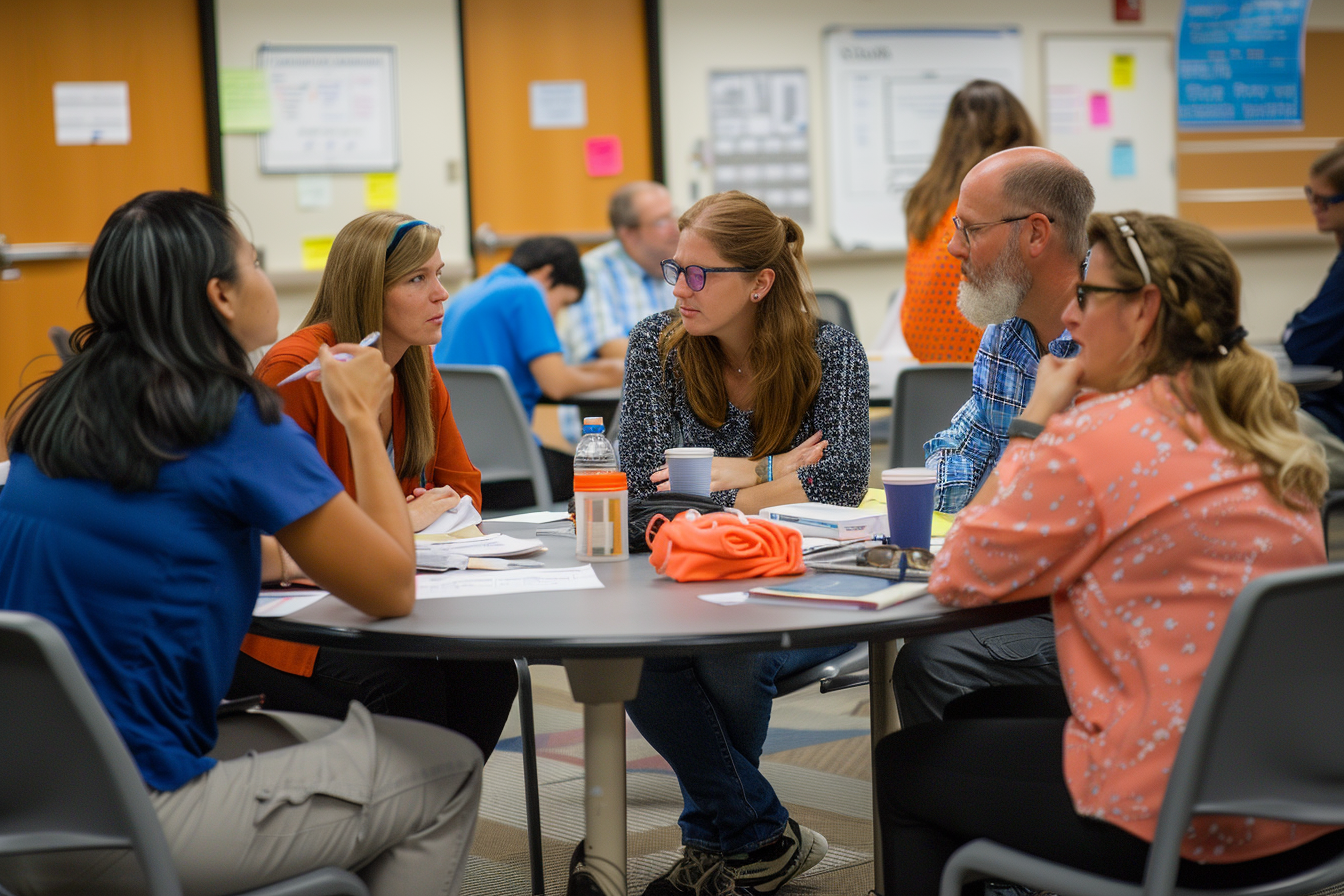Future Trends in Teacher Training: What Educators Need to Know
Explore future-ready, innovative teacher training: AI, VR, micro-credentials & collaborative PD to boost engagement and student success.

Imagine a classroom where every teacher feels confident, supported, and equipped with the latest strategies to engage and inspire their students. In today’s rapidly changing educational landscape, the traditional methods of teacher training are no longer sufficient to meet the diverse needs of modern classrooms. Innovative teacher training models are essential to prepare educators for these new challenges and opportunities.
As the role of teachers evolves, so must the ways we support their professional growth. From integrating technology to fostering inclusive learning environments, today's educators need training that is flexible, personalized, and ongoing. This post explores the various innovative models of teacher training that can transform teaching practices and enhance student outcomes.
We will delve into different types of training methods, their benefits, and practical strategies for implementation. Join us in exploring how these new approaches can revolutionize teacher training and create more effective, dynamic, and engaging classrooms.
Understanding Modern Teacher Training Needs
The educational landscape is continually evolving, placing new demands on teachers to adapt to diverse student needs, integrate technology, and manage dynamic classroom environments. Traditional teacher training methods often fall short in preparing educators for these challenges. Modern teacher training needs to be more flexible, ongoing, and tailored to individual teacher and student needs.
Key challenges faced by teachers today include addressing diverse learning styles and needs, effectively incorporating technology into the classroom, and creating an inclusive learning environment. Additionally, managing classroom dynamics and fostering student engagement require innovative approaches and continuous professional development.
Enjoy science fiction? Check out my space books HERE on Amazon!
The importance of ongoing professional development cannot be overstated. Lifelong learning for teachers is crucial to keep up with educational advancements and to continuously improve their teaching practices. Modern teacher training models aim to address these evolving needs by providing more personalized, engaging, and practical training opportunities.
Types of Innovative Teacher Training Models
Implementing innovative teacher training models involves utilizing a variety of methods to enhance professional development:
- Blended Learning Programs: These programs combine online and in-person training, allowing teachers to learn at their own pace while also benefiting from face-to-face interactions. This approach provides flexibility and access to a wide range of resources.
- Mentorship and Coaching: Pairing new teachers with experienced mentors helps provide guidance, support, and practical advice. Ongoing coaching fosters professional growth and helps teachers navigate challenges more effectively.
- Micro-Credentialing and Badging: Teachers can earn credentials for specific skills through short, focused courses. This allows for targeted professional development and recognition of specialized expertise.
- Collaborative Learning Communities: Professional Learning Communities (PLCs) and peer collaboration encourage teachers to share best practices, resources, and support. This collaborative approach fosters a culture of continuous improvement.
- Simulation and Gamification: Using simulations and game-based learning for teacher training makes the process more interactive and engaging. These methods allow teachers to practice and refine their skills in a safe, controlled environment.
These innovative models offer a more dynamic and effective approach to teacher training, ensuring that educators are well-prepared to meet the demands of modern classrooms.
Benefits of Innovative Teacher Training Models
Innovative teacher training models offer numerous benefits for educators and students alike:
- Personalized Professional Development: Tailoring training to individual teacher needs ensures that professional development is relevant and effective. Teachers can focus on areas where they need the most improvement, leading to more significant growth.
- Enhanced Teacher Engagement: Making training more interactive and relevant increases teacher engagement and motivation. Engaged teachers are more likely to implement new strategies effectively in the classroom.
- Improved Student Outcomes: Better-prepared teachers lead to improved student performance. When teachers are equipped with the latest strategies and tools, they can create more effective learning environments.
- Increased Retention Rates: Supporting teachers through innovative training methods helps reduce turnover. Teachers who feel supported and valued are more likely to stay in the profession.
- Fostering a Growth Mindset: Encouraging continuous improvement and innovation helps teachers develop a growth mindset. This mindset promotes lifelong learning and adaptability, essential qualities for educators in a rapidly changing world.
These benefits highlight the importance of adopting innovative teacher training models to enhance the overall quality of education.
Implementing Innovative Teacher Training Models
Implementing innovative teacher training models requires careful planning and a collaborative approach. The first step is conducting a needs assessment to identify specific training needs within the school or district. This involves gathering input from teachers, administrators, and other stakeholders to understand the areas that require focus.
Establishing a robust professional development infrastructure is crucial. Schools need to set up systems and resources to support ongoing training. This includes creating professional development plans, providing access to training materials, and setting up platforms for online learning.
Leveraging technology can significantly enhance teacher training. Digital tools and platforms, such as learning management systems and online courses, provide flexible and accessible training options. Utilizing technology also allows for more interactive and engaging training experiences.
Involving stakeholders in the training process is essential for its success. Engaging administrators, teachers, and the community ensures that the training programs are relevant and supported. This collaborative approach fosters a sense of ownership and commitment to the professional development process.
Continuous evaluation and feedback are necessary to maintain the effectiveness of training programs. Regularly assessing training outcomes, gathering feedback from participants, and making necessary adjustments help ensure that the training remains relevant and effective in meeting the evolving needs of educators.
Overcoming Challenges in Implementing New Training Models
Implementing innovative teacher training models can present several challenges, but these can be effectively managed with thoughtful strategies. Resource limitations are a common obstacle, but schools can address this by finding cost-effective training solutions, such as free online resources, grants, and community partnerships.
Resistance to change is another challenge, as some educators may be hesitant to adopt new methods. Addressing this reluctance involves clear communication about the benefits of innovative training models and providing support through professional development.
Time constraints can also pose a challenge, as teachers often have limited time for training amidst their teaching responsibilities. Balancing training with teaching duties requires careful scheduling and support from school administration.
Ensuring quality and consistency across training programs is crucial. Developing clear guidelines and criteria helps maintain high standards. Regular calibration sessions where teachers align their assessment practices can also help ensure consistency.
Case Studies
Implementing innovative teacher training models has led to notable successes in various educational settings across the country. Here are three case studies highlighting the impact of these methods:
Case Study 1: Blended Learning in a North Carolina School District
A school district in North Carolina integrated blended learning programs into their teacher training initiatives. Teachers participated in online courses complemented by in-person workshops. This approach provided flexibility and access to a wide range of resources. The results showed increased teacher engagement and improved teaching practices, leading to better student outcomes.
Case Study 2: Mentorship Programs in an Illinois Elementary School
An elementary school in Illinois implemented a mentorship program where new teachers were paired with experienced mentors. The mentors provided guidance, support, and practical advice to the new teachers. This program helped new teachers navigate challenges more effectively and fostered a supportive school culture. The initiative led to increased teacher retention rates and improved classroom management skills.
Case Study 3: Simulation-Based Training in an Arizona High School
A high school in Arizona adopted simulation-based training for their teachers. Using simulations and game-based learning, teachers practiced classroom management and instructional strategies in a controlled environment. This interactive approach made the training more engaging and allowed teachers to refine their skills. The program resulted in improved teacher confidence and classroom effectiveness.
Practical Tips for Educators
Implementing innovative teacher training models can be straightforward with the right approach and mindset. Here are some practical tips to help educators effectively incorporate new training methods into their professional development:
- Start Small: Begin with one or two innovative training methods and expand gradually. This allows for manageable implementation and adjustment.
- Collaborate with Colleagues: Share experiences and strategies within your school or district. Collaboration fosters a supportive environment and promotes the exchange of effective practices.
- Seek Out Resources: Utilize available tools and platforms for professional development. There are many free or low-cost resources that can enhance training experiences.
- Stay Informed: Keep up-to-date with the latest research and trends in teacher training. Continuous learning helps educators stay ahead of educational advancements.
- Reflect and Adjust: Continuously reflect on your training practices and make necessary adjustments. Regular reflection ensures that training remains relevant and effective.
These tips can help educators create a more dynamic and engaging professional development process that supports all teachers.
Future Trends in Teacher Training
The future of teacher training is evolving, with new trends enhancing its effectiveness and reach. AI and machine learning are becoming increasingly popular, offering personalized training experiences based on data. These technologies can provide immediate feedback and tailor training to individual teacher needs.
Virtual and augmented reality are also playing a role in teacher training, providing immersive simulations that allow teachers to practice skills in a realistic environment. These tools make training more interactive and engaging.
Check out our engaging printable posters. CLICK HERE to explore!
Global collaboration is another emerging trend, connecting teachers worldwide for shared learning experiences. This approach fosters cross-cultural understanding and the exchange of best practices.
Lifelong learning platforms are gaining traction, offering continuous professional development opportunities. These platforms provide access to a wide range of courses and resources, supporting ongoing teacher growth.
Data-driven decision making is becoming more prevalent, using data analytics to inform and improve training practices. Analyzing training data helps identify trends, strengths, and areas for improvement, leading to more effective and targeted professional development.
Conclusion
Embracing innovative teacher training models is essential for preparing educators to meet the evolving demands of modern classrooms. By incorporating blended learning, mentorship, micro-credentialing, collaborative learning communities, and simulation-based training, schools can offer more personalized and effective professional development. These methods not only enhance teacher engagement and retention but also lead to improved student outcomes and a more dynamic learning environment.
As education continues to evolve, staying updated with future trends such as AI, virtual reality, and global collaboration will be crucial. By adopting these innovative approaches and continuously refining training practices, schools can ensure that teachers are well-equipped to provide high-quality education and foster a culture of continuous improvement. Prioritizing innovative teacher training models will ultimately benefit educators, students, and the broader educational community, leading to a more inclusive and effective educational system.
Check out some of my latest science fiction books HERE on Amazon!
Transform your classroom into an inspiring and vibrant learning space with our beautifully designed printable posters! Perfect for engaging your students and enhancing your teaching environment, our poster bundles cover everything from historical philosophers to animals. CLICK HERE to explore our exclusive collections on Teachers Pay Teachers and give your students the motivational boost they need!
